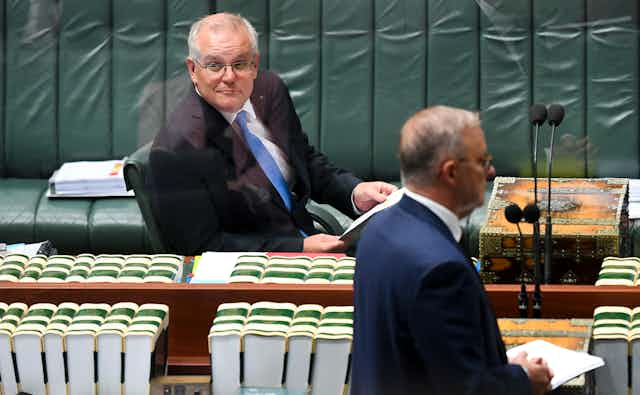This week’s Newspoll gives Labor a 55-45 lead over the Coalition, which is unchanged since the previous poll a fortnight ago.
The poll was conducted from February 23 to 26 from a sample of 1,525 people.
Coalition behind compared to 2019
Primary votes were 41% Labor (steady), 35% Coalition (up one), 9% Greens (up one), 4% Clive Palmer’s United Australia Party and 3% One Nation (steady). This is the first time Newspoll has given a breakout result for the United Australia Party during this parliamentary term. The “all others” vote is 8%, compared with 4% in last week’s Essential poll, 11.5% in Morgan and 15% in Resolve.
In this most recent Newspoll, 55% were dissatisfied with Prime Minister Scott Morrison (down one), and 43% were satisfied (up three), for a net approval of -12. Morrison has improved six net points from his late January nadir of -18.
Read more: Morrison's ratings slump in Resolve and Essential polls; Liberals set to retain Willoughby
Labor leader Anthony Albanese’s net approval jumped seven points to +1. His ratings have been bouncy in the last four Newspolls, at -6, zero, -6 and +1 net approval. Meanwhile, Morrison leads Albanese by 42-40 as better prime minister (it was 43-38 last fortnight).
With a federal election expected in May, analyst Kevin Bonham says that at about the same time before the 2019 vote, the Coalition polled 47% two party three times in a row, compared to 44%, 45% and 45% this year. This does not mean the Coalition will lose, but they are further behind this time.
Resolve poll
Last week’s Resolve poll also had the UAP at 4%. The other primary votes were 35% Labor, 33% Coalition, 10% Greens, 3% One Nation, 10% independents and 5% others.
In other Resolve questions, 65% (up seven since November) wanted to restart Australia’s migration at a lower level than the 160,000 per year before COVID-19. Just over half of those surveyed (53%) thought their income would fall behind inflation this year.
According to the Australian Bureau of Statistics wages rose 0.7% in the December quarter and 2.3% for the full 2021 year. But this means real wages fell 1.2% in 2021 with an inflation rate of 3.5%. As The Age reported real wages have fallen 0.8% since the 2019 election, the first time this century they have fallen in a parliamentary term.
Labor ahead in South Australia
The South Australian state election is coming up on March 19. A Newspoll conducted February 18 to 24 from a sample of 1,015, gave the Labor opposition a 53-47 lead over the Liberal incumbents. This compares to the 51.9 to 48.1 lead the Liberals had over Labor at the 2018 election. Primary votes were 39% Labor, 37% Liberals, 10% Greens and 14% for all others.
Premier Steven Marshall had a 48% satisfied, 47% dissatisfied rating (net +1), while Labor leader Peter Malinauskas was at net +20. Unusually for opposition leaders, Malinauskas led as better premier by 46-39.

At the 2018 election, the Liberals won 25 of the 47 lower house seats, Labor 19 and independents three. Three Liberals have since gone to the crossbench, so Marshall goes into the election with a minority.
In the upper house, 11 of the 22 seats will be elected by statewide proportional representation with preferences. The 11 seats up are five Liberals, four Labor, one Green and one Advance SA. The total upper house is currently nine Liberals, eight Labor, two SA-Best, two Greens and one Advance SA.
As the Poll Bludger writes, only votes cast on election day can be counted on the night in SA. These votes will likely be a low proportion of the overall turnout. It won’t be possible to call the result on election night unless it is very decisive.
Coalition and Labor almost tied in NSW
A NSW state Resolve poll for The Sydney Morning Herald has given the Coalition 37% of the primary vote (down four since November), Labor 34% (up three), the Greens 8% (down two), the Shooters 2% (steady), independents 13% (up one) and others 6% (up two).
As usual Resolve did not give a two party estimate, but Bonham says for Labor it’s about 50-50 at worst and they could be ahead.
Labor’s Chris Minns led incumbent Dominic Perrottet as preferred premier by 32-29 (it was 34-23 to Perrottet in November). Bonham says this is the first time the Labor leader has led a NSW preferred/better premier poll that allowed an undecided option since the 2011 Coalition landslide.
NSW byelections final results
Four NSW state byelections were held on February 12. All votes are now counted.
Read more: Mixed NSW byelection results do not imply voters in a 'baseball bat' mood
In Bega, Labor’s two party result was 55.0% – a 12.0% swing to the ALP. In Strathfield, it was 55.8%, with a 0.8% swing to Labor. In Monaro, the Nationals’ two party was 55.2%, with a 6.4% swing to Labor.
In Willoughby, the Liberals won 53.3% of the two-candidate vote against an independent. This is compared to 71.0% in 2019, when former premier Gladys Berejiklian easily defeated Labor.
Labor preferred in Queensland
The Courier Mail has also published the first Queensland state YouGov poll since the October 2020 election.
It gave Labor a 52-48 lead over the Liberal National Party (compared to 53.2-46.8 to the ALP at the election). Primary votes were 39% Labor, 38% LNP, 10% Greens and 8% One Nation.
Labor Premier Annastacia Palaszczuk had a 50% satisfied, 36% dissatisfied rating (net +14).

